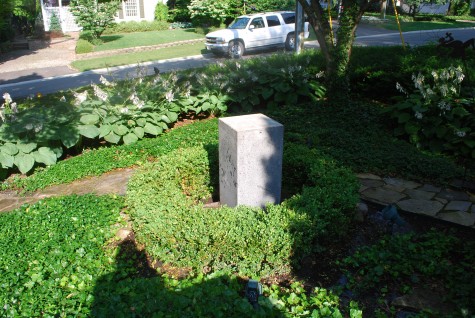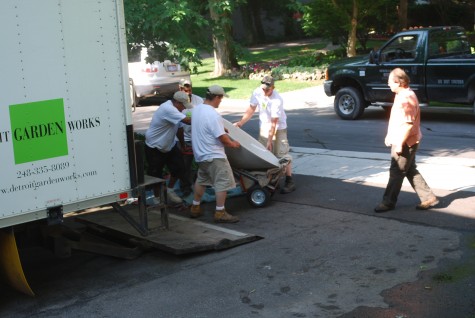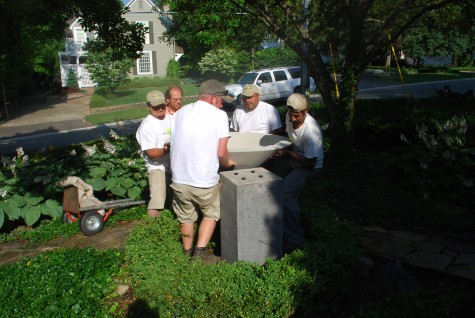 It helps me to define something, should I be able to give it a name. I could write a book about places, landscapes and their names. Detroit Garden Works-I named the shop by making a list of all those words that I thought best described what I had in mind. My city, my love of what goes on locally, the garden-of course, and works-as in works of art, in the works, working garden, work it out-you get the idea. My garden-Rob named it Corgi Run. It is a perfectly apt description of a landscape designed to accomodate two boisterous dogs of very short stature without looking like a dog run with decoration. The flowers are up high-as in roses, or containers, and the boxwood has corgi doors carved in their favorite entrance and exit spots. I have grass-and only the most rugged groundcover on the ground plane. My beloved beech ferns are on an intermediate level; the hellebores are outside the fence. Corgi Run-the name says it all. I wanted to design a handsome box with rugged good looks that would be equally at home in a contemporary landscape as a more traditional one. Subtle, stately, engaging. Naming it after Rock Hudson seemed just right. The Hudson River landscape paintings-handsome, and distinctly American paintings. OK, so I have an active imagination. Hudson-what does that word suggest to you? Try naming the place before you design and plant it-who knows where that might take you.
It helps me to define something, should I be able to give it a name. I could write a book about places, landscapes and their names. Detroit Garden Works-I named the shop by making a list of all those words that I thought best described what I had in mind. My city, my love of what goes on locally, the garden-of course, and works-as in works of art, in the works, working garden, work it out-you get the idea. My garden-Rob named it Corgi Run. It is a perfectly apt description of a landscape designed to accomodate two boisterous dogs of very short stature without looking like a dog run with decoration. The flowers are up high-as in roses, or containers, and the boxwood has corgi doors carved in their favorite entrance and exit spots. I have grass-and only the most rugged groundcover on the ground plane. My beloved beech ferns are on an intermediate level; the hellebores are outside the fence. Corgi Run-the name says it all. I wanted to design a handsome box with rugged good looks that would be equally at home in a contemporary landscape as a more traditional one. Subtle, stately, engaging. Naming it after Rock Hudson seemed just right. The Hudson River landscape paintings-handsome, and distinctly American paintings. OK, so I have an active imagination. Hudson-what does that word suggest to you? Try naming the place before you design and plant it-who knows where that might take you.
 The Hudson box has but a few details-a generously large molding at the top ordinarily used in the construction of iron handrails, and two smaller and simpler moldings, my obscure nod to a classic Italian terra cotta double rolled rim pot. The simplicity of the design lends itself to the construction of lots of different shapes. This particular rectangle fits the spot in a satisfying way. Spots that need square containers, or rectangular containers seem to need just the right size-not just any size. For years I had two round matching Italian terra cotta pots in this spot. The round worked fine,I like the fitted Hudson box better in this space.
The Hudson box has but a few details-a generously large molding at the top ordinarily used in the construction of iron handrails, and two smaller and simpler moldings, my obscure nod to a classic Italian terra cotta double rolled rim pot. The simplicity of the design lends itself to the construction of lots of different shapes. This particular rectangle fits the spot in a satisfying way. Spots that need square containers, or rectangular containers seem to need just the right size-not just any size. For years I had two round matching Italian terra cotta pots in this spot. The round worked fine,I like the fitted Hudson box better in this space.
 These squares were made to fit a specific space on a flight of cypress stairs. The boxes are in lieu of a handrail-a simple be careful on the stairs. The box in the background is home to an espaliered apple tree. We lined the box with styrofoam insulating sheeting; the tree has lived over the winter in the box for three seasons now. In this case, a very large box, capable of holding a considerable soil mass, seemed like a good idea for the health of the tree. The cypress deck is large and sparingly furnished-a big box works just fine here.
These squares were made to fit a specific space on a flight of cypress stairs. The boxes are in lieu of a handrail-a simple be careful on the stairs. The box in the background is home to an espaliered apple tree. We lined the box with styrofoam insulating sheeting; the tree has lived over the winter in the box for three seasons now. In this case, a very large box, capable of holding a considerable soil mass, seemed like a good idea for the health of the tree. The cypress deck is large and sparingly furnished-a big box works just fine here.
 I rarely buy window boxes for the shop-what size would I pick? No two windows are the same. I like window boxes that go wide of the windows, so it looks like the window has something substantial to sit on. This variation on the Hudson box with associated brackets were made for this specific window-and they look like it. There are actually three separate boxes. Part of this has to do with not placing too much stress on the wall when we hang them, but part has to do with the galvanzing process. A zinc bath of some 800 degrees can warp steel that is not adequately captured by a frame. Long boxes are particularly subject to damage. Now we build long or large boxes from a thicker steel.
I rarely buy window boxes for the shop-what size would I pick? No two windows are the same. I like window boxes that go wide of the windows, so it looks like the window has something substantial to sit on. This variation on the Hudson box with associated brackets were made for this specific window-and they look like it. There are actually three separate boxes. Part of this has to do with not placing too much stress on the wall when we hang them, but part has to do with the galvanzing process. A zinc bath of some 800 degrees can warp steel that is not adequately captured by a frame. Long boxes are particularly subject to damage. Now we build long or large boxes from a thicker steel.
 This Hudson box was outfitted with plumbing, and makes a fine fountain. The box has legs, so the boxwood skirt does not obscure too much of the detail of the bottom of the box. This year the boxwood covers the legs altogether. Hudson boxes make beautiful fountain cisterns.
This Hudson box was outfitted with plumbing, and makes a fine fountain. The box has legs, so the boxwood skirt does not obscure too much of the detail of the bottom of the box. This year the boxwood covers the legs altogether. Hudson boxes make beautiful fountain cisterns.
 Not every design looks so great in a very large size; this box is still graceful when it is large. It anchors this side door entrance garden with ease. My client plants for all four seasons; there is always something interesting going on. Driving up, she has a seasonal garden going on-dead ahead. The driveway garden-I have written before about the importance of the landscape that marks your arrival home. I may not get to every garden every day-but I do indeed drive up every day. I want to like what I see, when I come home.
Not every design looks so great in a very large size; this box is still graceful when it is large. It anchors this side door entrance garden with ease. My client plants for all four seasons; there is always something interesting going on. Driving up, she has a seasonal garden going on-dead ahead. The driveway garden-I have written before about the importance of the landscape that marks your arrival home. I may not get to every garden every day-but I do indeed drive up every day. I want to like what I see, when I come home.
 The largest of my Hudson boxes to date-a cistern 4′ by 8′. It was designed to be placed in an overscaled drivecourt. Without going into any detail, my client shares a driveway with two other homes; a big drivecourt was needed to handle family and friends. The size of this cistern breaks up a giant paved space, with a garden object of interest.
The largest of my Hudson boxes to date-a cistern 4′ by 8′. It was designed to be placed in an overscaled drivecourt. Without going into any detail, my client shares a driveway with two other homes; a big drivecourt was needed to handle family and friends. The size of this cistern breaks up a giant paved space, with a garden object of interest.
 This big red SUV has nothing on this Hudson box cistern -does it? Exactly my intention. Stately, handsome, graceful, bigger than life-this is how I remember Rock Hudson. Buck’s construction is true, square, level. This cistern, though the planting is yet to come, shows no signs of him wrestling this 1800 pound object as he welded it. It is a garden ornament of grace and dignity-I cannot wait to see the three fountain jets, representing.
This big red SUV has nothing on this Hudson box cistern -does it? Exactly my intention. Stately, handsome, graceful, bigger than life-this is how I remember Rock Hudson. Buck’s construction is true, square, level. This cistern, though the planting is yet to come, shows no signs of him wrestling this 1800 pound object as he welded it. It is a garden ornament of grace and dignity-I cannot wait to see the three fountain jets, representing.

This Hudson box is set in concert with a long and low window. It features an ever so slight bow front. Pictures of the summer planting to come. The Hudson box-I am pleased with it. Every one of these Hudson boxes were fabricated by Buck. A Buck week-he deserves it.

















